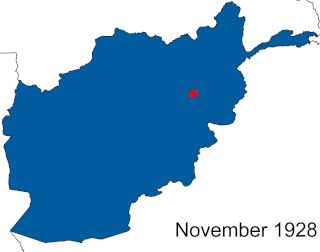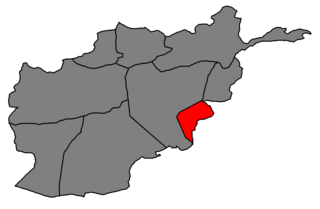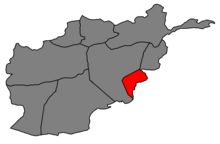
The Afghan Civil War was fought from 14 November 1928 to 13 October 1929. Rebelling, and subsequently governing Saqqawist (Saqāwīhā) forces under Habibullāh Kalakāni fought against various opposing tribes and rival monarchs in the Kingdom of Afghanistan, among whom Mohammed Nādir Khān eventually achieved a preponderant role. Despite early successes, such as the capture of Kabul and defeat of Amanullah Khan on 17 January 1929 or the capture of Kandahar on 3 June, the Saqqawists were eventually deposed by anti-Saqqawist forces led by Nadir on 13 October 1929, leading to Nadir's ascension as King of Afghanistan, who ruled until his assassination on 3 November 1933.

Inayatullah Khan, was the King of Afghanistan for three days in January 1929. He was the son of former Afghan Emir, Habibullah Khan. Inayatullah's brief reign ended with his abdication.

Habibullah Kalakani, derided by Pashtun as "Bacha-ye Saqao" was the ruler of Afghanistan from 17 January to 13 October 1929, and as well as a leader of the Saqqawists. During the Afghan Civil War, he captured vast swathes of Afghanistan and ruled Kabul during what is known in Afghan historiography as the "Saqqawist period". He was an ethnic Tajik. No country recognized Kalakani as ruler of Afghanistan.

Faiz Muhammad Kāteb also known as Kāteb (کاتب) was a writer and historian. He was Afghan court chronicler, a skilled calligrapher and secretary to Habibullah Khan from 1901 to 1919.
Robert Duncan McChesney is a scholar of the social and cultural history of Central Asia, Iran, and Afghanistan.

The Mangal are a tribe of the Pashtun people residing in eastern Paktia and adjacent Khost provinces of Afghanistan.
Takhteh Pol, also known as Takhtapul, is a village in Balkh Province in northern Afghanistan. It was created in by Afzal Khan as a cantonment after the Afghan conquest of the Balkh Wilayat in 1849-1850. Balkh was in ruins, so with materials from the ruined town of Balkh, he established the city of Takhtapul. Gardens and courts were created as well. Within three years the city was established.
Mazar-i-Sharif Province is a defunct province of Afghanistan, which in 1964 was divided into Balkh Province and Jowzjan Province. The former province's capital was Mazar-i-Sharif.
Burhanuddin Kushkaki, also known as Mawlawi Borhan al-Din Khan Koshkaki, (1894–1953) was an Afghan writer, journalist and Islamic scholar.

Mohammad Nadir Shah was King of Afghanistan from 15 October 1929 until his assassination in November 1933. Previously, he served as Minister of War, Afghan Ambassador to France, and as a general in the Royal Afghan Army. He and his son Mohammad Zahir Shah, who succeeded him, are part of the Musahiban.

The Khost rebellion, also known as the 1924 Mangal uprising, the Khost revolt or the Mangal Revolt was an uprising against the Westernization and modernizing reforms of Afghanistan’s king, Amanullah Khan. The uprising was launched in Southern Province, Afghanistan, and lasted from March 1924 to January 1925. It was fought by the Mangal Pashtun tribe, later joined by the Sulaiman Khel, Ali Khel, Jaji, Jadran and Ahmadzai tribes. After causing the death of over 14,000 Afghans, the revolt was finally quelled in January 1925.

Turkestan Province was a province in Afghanistan.

Slavery in Afghanistan was present in the post-Classical history of Afghanistan, continued during the Middle Ages, and persisted into the 1920s.

Amir Ali Ahmad Khan, Shaghasi was an Afghan king from the Shaghasi family of the Barakzai tribe who was declared king of Afghanistan twice in 1929. He was first declared amir of Afghanistan by and influential cleric, Naqib Sahib on 20 January 1929, in eastern Afghanistan, but was defeated by Kalakani at Jagdalak on 19 February 1929. He was also declared as the amir of Afghanistan for the second time on 23 June 1929 in Kandahar, Afghanistan, by another highly influential Mufti Abd. Wasi Kandahari, but was defeated and captured by Kalakani on 3 July 1929.

The Saqqawists were an armed group in Afghanistan who were active from 1924 to 1931. They were led by Habibullāh Kalakāni, and in January 1929, they managed to take control of the capital of the Kingdom of Afghanistan, Kabul, reestablishing the Emirate of Afghanistan. Following military reversals in the Afghan Civil War (1928–1929), they were forced out of the capital in October 1929. Saqqawist activity ended in 1931.

The Emirate of Afghanistan was an unrecognized state ruled by the Saqqawists that existed from January to October 1929. Habibullāh Kalakāni became the state's only emir on 18 January 1929. After the fall of Kalakāni on 13 October 1929, the Emirate ended.

Amanullah loyalism was a series of early 20th century movements in the Kingdom of Afghanistan to restore Amanullah Khan as king of Afghanistan after he was deposed in January 1929 during the Afghan Civil War. Loyalists were sometimes referred to as Amanite. Loyalists tried to achieve this in various ways, including armed rebellions, political parties, colluding with foreign powers and assassinations. These movements petered out by the late 1940s. Amanullah died in exile in 1960 in Zürich, Switzerland, without ever regaining control, except a brief period of control in southern Afghanistan in the 1929 Afghan Civil War.
Throughout the history of Afghanistan, there have been many flags used by rebel groups in Afghanistan's various conflicts. This is a list of the Afghan rebel flags flown by various groups throughout the country's history.
Purdil Khan was an Afghan Saqqawist politician who served as minister of defence under Habibullāh Kalakāni during the Afghan Civil War of 1928–29, and briefly became the leader of the movement during a rebellion in July 1930.












